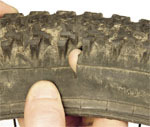 A ripped sidewall is going to stop you dead in your tracks because the split tube will be impossible to repair and you’ll need to cover the rip in the tyre before you fit a replacement tube. If it’s dry and dusty, and the tear isn’t too big, then a piece of card is more than enough, but if it’s wet, the card can disintegrate. A fix for this is to use a waterproof patch such as a section of the punctured tube or a short section of tyre — roadie tyre is actually best for this. If the tear is big, the piece of card can also move around, exposing the inner tube.
A ripped sidewall is going to stop you dead in your tracks because the split tube will be impossible to repair and you’ll need to cover the rip in the tyre before you fit a replacement tube. If it’s dry and dusty, and the tear isn’t too big, then a piece of card is more than enough, but if it’s wet, the card can disintegrate. A fix for this is to use a waterproof patch such as a section of the punctured tube or a short section of tyre — roadie tyre is actually best for this. If the tear is big, the piece of card can also move around, exposing the inner tube.
The only solution then is to try and stick it together with either some tape or a Park Tyre Boot, which is effectively a big thick patch. This isn’t a 100 per cent fix but, with the tube inflated, it does keep the tear together. It’s worth carrying a couple of these in your pack, especially if you know you have lightweight sidewalls or you are going on some big rides in rocky terrain (we’d definitely take them on marathon events).
For the full belt-and-braces fix, wrap several loops of tape round the new tube before you fit it, remembering to partially inflate the tube first because most tape won’t stretch once the tube expands. If things are really bad then you can wrap tape round the outside of the tyre — this is also a good fix if the bead has split. Obviously you’re going to have problems if you’re running old-skool cantilevers or V-brakes, but you can always unhook them or remove them entirely if they’re in the way. Remember this isn’t a permanent fix; you just want to get home quickly, which is important if it’s freezing cold or too far to walk back.

TOOLS FOR THE JOB:
Tyre levers
Park Tyre Boot (pack of three £2.95),
Gaffer tape
Spare tube
Knife

1 Remove the tyre.

2 Find the rip. It’s not always on the sidewall; sometimes it can extend up into the tread.

3 You need to cover the hole to stop the replacement tube blebbing out when you pump up the tyre. Any piece of card will do; we’ve used part of the box the tube came in.

4 Business cards are a little thicker and we’ve used ours in the past.

5 Park makes a Tyre Boot, which is a kind of big patch. It’s also sticky, so should hold the split together when you pump up the tube.

6 If you have some tape in your pack, wrap a couple of loops round the tube in line with the hole. Make sure the tube is partially inflated first.

7 If you have no gaffer tape, use a plaster.

8 A selection of things you can use to pack the tube — card, tape, Park Tyre Boot, piece of inner tube cut from the punctured one, piece of old tyre (this is a roadie tyre with the beads cut off). You could also use PowerBar wrappers, jazz mags or, at a push, even a thick leaf folded over a couple of times.

9 Make sure the tear is dead centre on whatever patch you use.

10 How bad the split is, and how successful you’ve been at mending it, dictates how hard you can inflate the tyre before the tube blebs out. We’d err on the sign of caution, but equally, take it easy running a low pressure because there’s an increased risk of pinch flats.

11 Stop inflating the tyre once the split opens or the repair starts to bulge out.

12 If the split is really big or along the sidewall, wrap several loops of tape round the outside of the wheel.
TOP TIPS:
It’s patently obvious, but the easy way to reduce rips is to use tyres with thicker sidewalls.
If you’re using an old-skool puncture outfit, a dab of patch glue on the back of the card/inner tube/tyre will hold it in place.
Wrap a short length of gaffer tape round your spare tube. This is not only handy for this repair, it has plenty of other uses.
Running tubeless? Follow the same procedure. Remove the tubeless valve stem and fit a new tube as normal.



